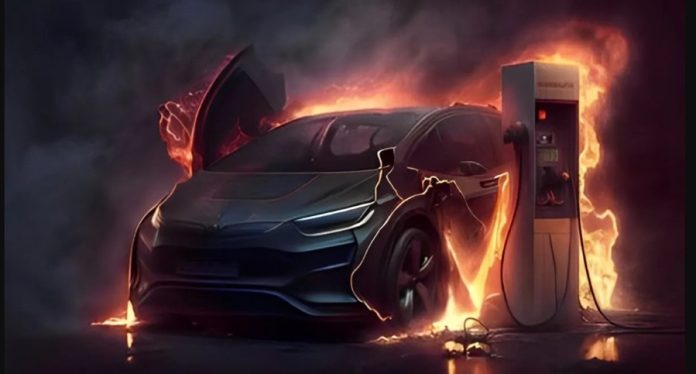Recent findings indicate that electric vehicles (EVs) do not present a higher fire risk compared to conventional gasoline-powered vehicles. Andrew Klock, a senior manager at the National Fire Protection Association, emphasizes that EVs are “not more dangerous, just different.”
How EV Battery Fires Occur
Battery fires in EVs stem from a process called thermal runaway. This occurs when a battery cell short circuits, causing it to overheat. If this cell’s heat spreads, nearby cells can also fail, triggering a chain reaction. During thermal runaway, compromised battery cells release oxygen, which can fuel a fire. To halt this process, the battery’s temperature needs to be lowered, usually by dousing the battery pack with water directly. It currently takes around 2,500 gallons of water to extinguish an EV fire, compared to about 500–1,100 gallons for a gasoline engine fire.
Thermal runaway is more common in certain types of batteries, particularly those with nickel manganese and cobalt oxide (NMC) cathodes. However, the industry is increasingly shifting to lithium iron phosphate (LFP) cathodes, which are known for their thermal stability and reduced risk of thermal runaway. As this shift continues, the risk of EV fires is expected to decline. Solid-state batteries, a next-generation technology under development, promise to lower fire risks even more by replacing flammable liquid electrolytes with solid, non-flammable ones.
EV Battery Fires: Analyzing the Data
Data from EV FireSafe, an Australian organization monitoring EV fires, shows that between 2010 and June 2024, there were just over 500 battery-related fires in light-duty EVs worldwide. With around 40 million EVs on the road by 2024, this equates to about 1 fire in 100,000 vehicles. Tesla estimates that one of its vehicles catches fire every 130 million miles driven, which is roughly the equivalent of one fire every 23,400 trips between New York and Los Angeles. In contrast, the National Fire Protection Association reports that fires in all vehicle types occur every 18 million miles—making gasoline-powered vehicles over seven times more likely to catch fire.
Between 2013 and 2017, the U.S. recorded an annual average of 117,370 passenger vehicle fires, equating to one fire every five minutes. Although U.S. data does not differentiate between gasoline-powered and EV fires, data from Sweden provides a clearer picture. Based on this data, analysts at MotorTrend concluded that gasoline and diesel vehicles are 29 times more likely to experience a fire than electric vehicles or conventional hybrids.
It’s important to highlight that fire risks generally rise as vehicles age. Since the EV fleet is newer compared to gasoline-powered cars, keeping a close watch will be essential as the number of aging EVs on the road increases.
Global Research on EV Battery Fire Prevention
Various countries are studying best practices to address the risk of EV battery fires. In the U.S., the National Highway Traffic Safety Administration’s Battery Safety Initiative is leading research into EV battery safety. This initiative monitors incidents like crashes that could compromise battery safety, explores topics such as battery health monitoring and cybersecurity, and oversees recalls and investigations into battery-related issues. The program also pushes for new regulations, such as a proposal requiring automakers to develop emergency response guides for each EV model.
Multiple countries are actively tackling EV fire concerns by implementing policies and regulations. For example, stronger sprinkler systems and smoke detectors in parking garages, and stricter physical and chemical safety standards for battery cells are just a few of the strategies being implemented. Additional fire prevention tactics include limiting where chargers can be installed in parking structures and ensuring that chargers are shielded from potential impact with curbs or posts.
Looking Forward
In conclusion, current evidence suggests that EVs do not present a higher fire risk than gasoline-powered vehicles. As battery technology advances and safer chemistries like LFP become more common, EV fire risks are likely to decrease even further. Moreover, the frequency of fires in older gasoline-powered vehicles far exceeds that of EVs, making the overall fire risk lower in electric vehicles. The ongoing development of solid-state batteries holds the promise of further improving safety in the future.








